Wikipedia:Picture of the day/June 2021
|
Featured picture tools: |
These featured pictures, as scheduled below, appeared as the picture of the day (POTD) on the English Wikipedia's Main Page in June 2021. Individual sections for each day on this page can be linked to with the day number as the anchor name (e.g. [[Wikipedia:Picture of the day/June 2021#1]] for June 1).
You can add an automatically updating POTD template to your user page using {{Pic of the day}} (version with blurb) or {{POTD}} (version without blurb). For instructions on how to make custom POTD layouts, see Wikipedia:Picture of the day.Purge server cache
June 1

|
This historical depiction of the coat of arms of Kentucky was illustrated by the American engraver Henry Mitchell in State Arms of the Union, published in 1876 by Louis Prang. The design depicts two men embracing, with the motto "United we stand, divided we fall". The original Kentucky state seal, adopted in 1792 and designed in 1793, was lost in a fire that destroyed the state capitol in 1814. Because the description originally adopted by the General Assembly did not specify how the "two friends" should look or how they should be embracing, several variants have been produced. Illustration credit: Henry Mitchell; restored by Andrew Shiva
Recently featured:
|
June 2

|
Célestine Galli-Marié (1837–1905) was a French mezzo-soprano who is most famous for creating the title role in the opera Carmen by Georges Bizet. It was said that, during the opera's 33rd performance on 2 June 1875, Galli-Marié had a premonition of Bizet's death while singing in the third act, and fainted when she left the stage; the composer in fact died that night and the next performance was cancelled due to her indisposition. This photograph by Nadar depicts Galli-Marié as the titular character in Carmen. Photograph credit: Nadar; restored by Adam Cuerden
Recently featured:
|
June 3

|
The double-banded plover (Charadrius bicinctus) is a species of bird in the plover family native to New Zealand. During the winter and the spring, it has a dark, greyish-brown back with a distinctive white chest, a thin band of black below the neck running across the chest, and a thicker brown band below. Outside the breeding season, the double-banding is lost; this photograph, taken in March, shows a double-banded plover in non-breeding plumage at Boat Harbour in New South Wales, Australia. Photograph credit: John Harrison
Recently featured:
|
June 4

|
The Book of Tobit is a Jewish work from the 3rd or early 2nd century BCE describing how God tests the faithful, responds to prayers, and protects the covenant community (the Israelites). It is regarded as part of the biblical canon of the Catholic and Orthodox churches as a deuterocanonical book, but as part of the biblical apocrypha in some Protestant churches. This 15th-century oil-on-panel painting by Filippino Lippi, entitled Tobias and the Angel, depicts a scene in which Tobias, Tobit's son, goes on a journey accompanied by an angel, without realising that he is an angel, and is instructed what to do with the giant fish that he catches. Painting credit: Filippino Lippi
Recently featured:
|
June 5

|
Ben-Gurion's hut was the retirement home of David Ben-Gurion, the first prime minister of Israel, and his wife Paula from 1953 until his death in 1973. The "hut", located in Sde Boker, a kibbutz in the Negev, in southern Israel, was preserved exactly as it was left by Ben-Gurion after his death, and now serves as a museum with a visitors' center operated by the Ben-Gurion Heritage Institute. Photograph credit: Hanan Epstein
Recently featured:
|
June 6

|
Al Grey (June 6, 1925 – March 24, 2000) was an American jazz trombonist who was known for his plunger-mute technique. After serving in World War II, he joined Benny Carter's band, then the bands of Jimmie Lunceford, Lucky Millinder, and Lionel Hampton. In the 1950s, he was a member of the big bands of Dizzy Gillespie and Count Basie before forming his own bands in the 1960s. This photograph by William P. Gottlieb shows Grey still performing into the 1980s. Photograph credit: William P. Gottlieb; restored by Adam Cuerden
Recently featured:
|
June 7
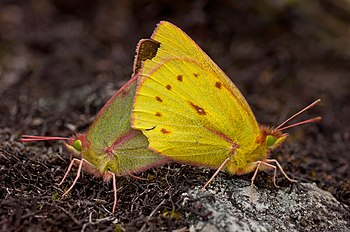
|
Sexual dimorphism is the condition where the two sexes of the same species exhibit different characteristics. Differences may include secondary sex characteristics, size, weight, color, or markings, as well as behavioral and cognitive differences. In the butterfly species Colias dimera (also known as the Dimera sulphur), seen here mating in Venezuela, the male on the right is a brighter shade of yellow than the female. Photograph credit: Paolo Costa Baldi
Recently featured:
|
June 8

|
Lucy Arbell (8 June 1878 – 21 May 1947), was a French mezzo-soprano whose operatic career was largely centred in Paris. Her career was particularly associated with the composer Jules Massenet, who created a number of operatic roles for her before his death in 1912. This carte de visite of Arbell was created by the French photographer Nadar. Photograph credit: Nadar; restored by Adam Cuerden
Recently featured:
|
June 9

|
The California State Capitol, located in Sacramento, is the seat of the California government. The building houses the chambers of the California State Legislature, comprising the Assembly and the Senate, along with the office of the governor of California. The Neoclassical structure was designed by Reuben S. Clark and completed between 1861 and 1874. The California State Capitol Museum is housed on its grounds. Photograph credit: Andre m
Recently featured:
|
June 10

|
|
Artists producing art and engraving on United States banknotes transitioned to steel engraving, which enabled a rapid advance in banknote design and printing, during the 19th century. This vignette, engraved by Charles Burt for the Department of the Treasury's Bureau of Engraving and Printing, depicts the baptism of Pocahontas, and is a copy of an 1840 painting by John Gadsby Chapman on display in the United States Capitol rotunda. From 1875, the vignette was used on the reverse of twenty-dollar bills as part of the first issue of National Bank Notes. Engraving credit: Charles Burt, after John Gadsby Chapman; restored by Andrew Shiva
Recently featured:
|
June 11
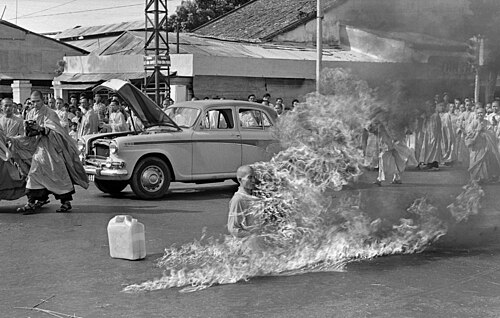
|
|
Thích Quảng Đức was a Vietnamese Mahayana Buddhist monk who burned himself to death at a busy road intersection in Saigon on 11 June 1963, in protest against the persecution of Buddhists by the South Vietnamese government led by Ngô Đình Diệm. Images of the act were circulated widely around the world and brought attention to the policies of the Diệm government. This photograph of Quảng Đức's self-immolation was captured by the American journalist Malcolm Browne for the Associated Press; Browne later won the 1963 World Press Photo of the Year and a Pulitzer Prize for his photographs of the act. Photograph credit: Malcolm Browne
Recently featured:
|
June 12

|
The common blackbird (Turdus merula) is a species of true thrush, in the family Turdidae. It breeds in Europe, Asiatic Russia, and North Africa, and has a number of subspecies across its wide range; a few of the Asian subspecies are sometimes considered to be full species. Depending on latitude, the common blackbird may be resident, partially migratory, or fully migratory. This female northwestern African blackbird (T. m. mauritanicus) was photographed in the Souss-Massa National Park, Morocco. This small, dark subspecies breeds in central and northern Morocco, coastal Algeria and northern Tunisia. Photograph credit: Charles James Sharp
Recently featured:
|
June 13

|
Lichfield Cathedral is an Anglican cathedral in Lichfield, Staffordshire. A church was first built on the site in 700 by Bishop Headda to house the bones of Saint Chad of Mercia. The original wooden building was replaced by a Norman cathedral made from stone, which in turn was replaced by the present Gothic structure, begun in 1195. The cathedral suffered extensive damage during the English Civil War: the central spire was demolished, the roofs ruined and the stained-glass windows smashed. Bishop John Hacket began the restoration in the 1660s, but the damage was not fully repaired until the 19th century. This photograph shows the exterior of the cathedral as seen from the northeast. Photograph credit: David Iliff
Recently featured:
|
June 14
Subpage 1
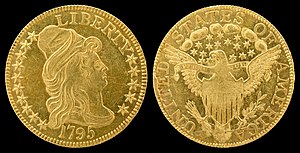
|
The half eagle is a United States coin that was produced for circulation from 1795 to 1929 and in commemorative and bullion coins since the 1980s. Made almost entirely of gold, it has a face value of five dollars. It was the first gold coin to be minted by the United States, authorized by the Coinage Act of 1792. Originally designed by Robert Scot, the design and composition of the half eagle has changed many times over the years. This half eagle, known as a "Turban Head", was minted in 1795 and is now part of the National Numismatic Collection. The coin's obverse depicts a personification of Liberty wearing a cap, while the reverse depicts a heraldic eagle. Other designs:Coin design credit: Robert Scot; photographed by Jaclyn Nash
Recently featured:
|
Subpage 2

|
The half eagle is a United States coin that was produced for circulation from 1795 to 1929 and in commemorative and bullion coins since the 1980s. Composed almost entirely of gold, it has a face value of five dollars. It was the first gold coin to be minted by the United States, its production being authorized by the Coinage Act of 1792. The design and composition of the half eagle changed many times over the years, but it was originally designed by Robert Scot. This type was produced from 1795 to 1798; the obverse design depicts a turbaned portrait of Liberty facing to the right, and the reverse depicts a small eagle. Other designs:National Numismatic Collection, National Museum of American History; photographed by Jaclyn Nash
Recently featured:
|
Subpage 3
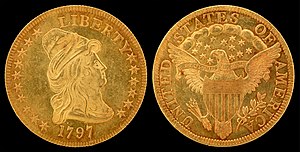
|
The half eagle is a United States coin that was produced for circulation from 1795 to 1929 and in commemorative and bullion coins since the 1980s. Composed almost entirely of gold, it has a face value of five dollars. It was the first gold coin to be minted by the United States, its production being authorized by the Coinage Act of 1792. The design and composition of the half eagle changed many times over the years, but it was originally designed by Robert Scot. The obverse design depicts a turbaned portrait of Liberty facing to the right, and the reverse depicts a heraldic eagle; this type was produced in 1797 and was unique in having 16 stars on the obverse. Other designs:National Numismatic Collection, National Museum of American History; photographed by Jaclyn Nash
Recently featured:
|
Subpage 4

|
The half eagle is a United States coin that was produced for circulation from 1795 to 1929 and in commemorative and bullion coins since the 1980s. Composed almost entirely of gold, it has a face value of five dollars. It was the first gold coin to be minted by the United States, its production being authorized by the Coinage Act of 1792. The design and composition of the half eagle changed many times over the years, but this version was designed by John Reich and produced from 1807 to 1812. The obverse design depicts a round-capped portrait of Liberty facing to the left, and the reverse depicts a modified eagle. For the first time, "5 D." is included on the reverse to indicate the value of the coin. Other designs:National Numismatic Collection, National Museum of American History; photographed by Jaclyn Nash
Recently featured:
|
Subpage 5
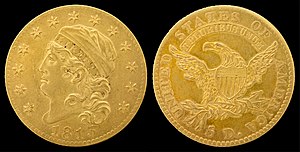
|
The half eagle is a United States coin that was produced for circulation from 1795 to 1929 and in commemorative and bullion coins since the 1980s. Composed almost entirely of gold, it has a face value of five dollars. It was the first gold coin to be minted by the United States, its production being authorized by the Coinage Act of 1792. The design and composition of the half eagle changed many times over the years, but this version was designed by John Reich and produced from 1813 to 1834. The obverse design depicts a round-capped portrait of Liberty facing to the left, and the reverse depicts a modified eagle. This type differs from its predecessor by Liberty having a larger head and a reduced bustline. Other designs:National Numismatic Collection, National Museum of American History; photographed by Jaclyn Nash
Recently featured:
|
Subpage 6
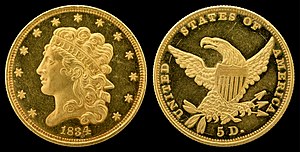
|
The half eagle is a United States coin that was produced for circulation from 1795 to 1929 and in commemorative and bullion coins since the 1980s. Composed almost entirely of gold, it has a face value of five dollars. It was the first gold coin to be minted by the United States, its production being authorized by the Coinage Act of 1792. The design and composition of the half eagle changed many times over the years, but this version was designed by William Kneass and produced from 1834 to 1838. The obverse design depicts a classic portrait of Liberty facing to the left, and the reverse depicts a modified eagle, with "E PLURIBUS UNUM" removed. Other designs:National Numismatic Collection, National Museum of American History; photographed by Jaclyn Nash
Recently featured:
|
Subpage 7
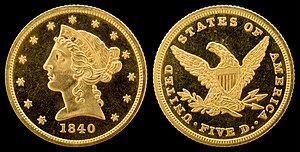
|
The half eagle is a United States coin that was produced for circulation from 1795 to 1929 and in commemorative and bullion coins since the 1980s. Composed almost entirely of gold, it has a face value of five dollars. It was the first gold coin to be minted by the United States, its production being authorized by the Coinage Act of 1792. The design and composition of the half eagle changed many times over the years, but this version was designed by Christian Gobrecht and produced from 1839 to 1866. The obverse design depicts a classic portrait of Liberty facing to the left, and the reverse depicts a modified eagle, with the value changed from "5 D." to "FIVE D.". Other designs:National Numismatic Collection, National Museum of American History; photographed by Jaclyn Nash
Recently featured:
|
Subpage 8
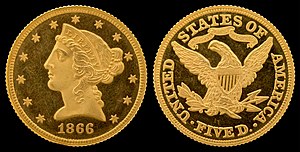
|
The half eagle is a United States coin that was produced for circulation from 1795 to 1929 and in commemorative and bullion coins since the 1980s. Composed almost entirely of gold, it has a face value of five dollars. It was the first gold coin to be minted by the United States, its production being authorized by the Coinage Act of 1792. The design and composition of the half eagle changed many times over the years, but this version was designed by Christian Gobrecht and produced in 1866. The obverse design depicts a portrait of Liberty facing to the left, and the reverse depicts a modified eagle, with the addition of the motto "IN GOD WE TRUST" above the eagle. Other designs:National Numismatic Collection, National Museum of American History; photographed by Jaclyn Nash
Recently featured:
|
Subpage 9
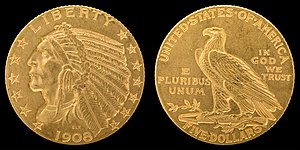
|
The half eagle is a United States coin that was produced for circulation from 1795 to 1929 and in commemorative and bullion coins since the 1980s. Composed almost entirely of gold, it has a face value of five dollars. It was the first gold coin to be minted by the United States, its production being authorized by the Coinage Act of 1792. The design and composition of the half eagle changed many times over the years, but this version was designed by Bela Pratt and produced from 1908 onwards. The obverse design depicts an Indian head wearing a feathered headdress facing to the left, and the reverse depicts a perched eagle with the inscriptions "E PLURIBUS UNUM" and "IN GOD WE TRUST". Other designs:National Numismatic Collection, National Museum of American History; photographed by Jaclyn Nash
Recently featured:
|
Subpage 10

|
The half eagle is a United States coin that was produced for circulation from 1795 to 1929 and in commemorative and bullion coins since the 1980s. Composed almost entirely of gold, it has a face value of five dollars. It was the first gold coin to be minted by the United States, its production being authorized by the Coinage Act of 1792. The design and composition of the half eagle changed many times over the years, but this version was designed by John Reich and produced from 1813 to 1834. The obverse design depicts a round-capped portrait of Liberty facing to the left, and the reverse depicts a modified eagle. This 1822 coin is one of only three known for the year. National Numismatic Collection, National Museum of American History; photographed by Andrew Shiva
Recently featured:
|
June 15

|
Bessie Coleman (1892–1926) was a civil aviator. On June 15, 1921, she became the first African-American woman and the first Native American to earn an aviation pilot's license. Denied opportunity in the United States because of her race and sex, she had to go to France to learn to fly. Her career involved stunt flying and performing in air shows, and was cut short in 1926 when she was thrown from a plane in mid-air. Her death meant that her ambition to establish a school for young black aviators went unaccomplished, but her pioneering achievements served as an inspiration for a generation of African-American men and women. Photograph credit: Unknown
Recently featured:
|
June 16

|
H.M.S. Pinafore is a comic opera in two acts, with music by Arthur Sullivan and a libretto by W. S. Gilbert, first performed in 1878. The Gilbert and Sullivan work was very popular in the United Kingdom, the United States, and elsewhere. It continues to be regularly performed today, and has sparked a number of adaptations. This illustration, depicting a sailor on a ship's rigging, forms the frontispiece to The Pinafore Picture Book, a 1909 children's book by Gilbert and illustrated by Alice B. Woodward. The book retells the story of Pinafore, in some cases giving considerable backstory that is not found in the libretto. Illustration credit: Alice B. Woodward; restored by Adam Cuerden
Recently featured:
|
June 17

|
|
Pyrosoma atlanticum is a species of deep-water colonial tunicate found in oceans around the world. The colony forms a hollow cylinder that can grow up to 60 cm (24 in) long. The constituent zooids, which may be pink, yellowish, or bluish, form a rigid tube; each zooid has a pair of luminescent organs which can be turned on and off, causing a rhythmic flashing. No neural pathway runs between the zooids, but each responds to the light produced by other individuals, and even to light from nearby colonies. This P. atlanticum colony was photographed in a tide pool in Pacific Grove, California. Photograph credit: Rhododendrites
Recently featured:
|
June 18
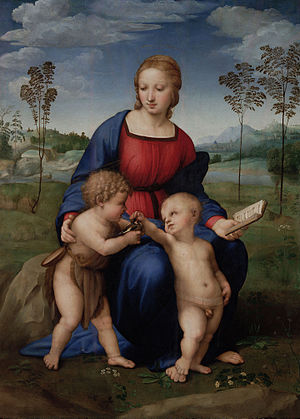
|
The Madonna del cardellino (Madonna of the Goldfinch) is an oil-on-panel painting by the Italian Renaissance artist Raphael, created around 1505–1506. It depicts the Virgin Mary, the Christ Child, and the young John the Baptist, holding a goldfinch in his hand, which Christ is reaching out to touch. A ten-year restoration of the painting was completed in 2008, and the work is now in the collection of the Uffizi in Florence. Painting credit: Raphael
Recently featured:
|
June 19
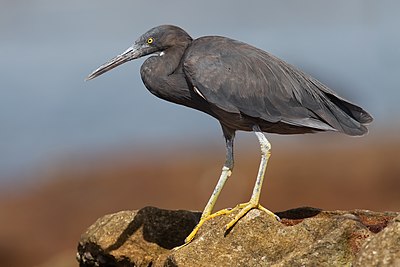
|
The Pacific reef heron (Egretta sacra) is a species of heron found throughout southern Asia and Oceania. About 60 cm (24 in) in length, this species has two distinct colour morphs, charcoal-grey (as seen here) and pure white. The bird's diet consists mainly of fish, crustaceans and molluscs. This Pacific reef heron was photographed at Boat Harbour, in New South Wales, Australia. Photograph credit: John Harrison
Recently featured:
|
June 20

|
Benjamin Bristow (June 20, 1832 – June 22, 1896) was an American lawyer and politician who served as the 30th United States secretary of the treasury and the first solicitor general. Historians primarily admire Bristow's prosecution and shutting down the Whiskey Ring during his term as President Grant's treasury secretary. Although a lawyer by trade and having no financial training, he was able to rid the Internal Revenue Service of corruption. This line engraving of Bristow was produced by the Department of the Treasury's Bureau of Engraving and Printing (BEP) as part of a BEP presentation album of the first 42 secretaries of the treasury. Engraving credit: Bureau of Engraving and Printing; restored by Andrew Shiva
Recently featured:
|
June 21

|
Jane Russell (June 21, 1921 – February 28, 2011) was an American actress, singer, and model who became one of Hollywood's leading sex symbols in the 1940s and 1950s. This publicity still, depicting Russell reclining on a bed of hay and holding a pistol, was taken by George Hurrell for her film debut in Howard Hughes's film The Outlaw (1943), which launched her career. She went on to star in more than twenty films, including opposite Marilyn Monroe in the hugely successful Gentlemen Prefer Blondes (1953). Photograph credit: George Hurrell
Recently featured:
|
June 22

|
Joseph Simpson (1879–1939) was a British painter, illustrator and etcher. This illustration by Simpson, entitled "Your Motherland Will Never Forget", was published by the Canadian War Records Office in the magazine Canada in Khaki. It depicts a personification of the "Motherland" welcoming back a First World War soldier returning victorious from the front, as suggested by the German helmets on the soldier's backpack. Published in Toronto between 1917 and 1919, the publication described the participation of Canadians in World War I and aimed to raise money for the Canadian War Memorial Fund. Illustration credit: Joseph Simpson; restored by Adam Cuerden
Recently featured:
|
June 23
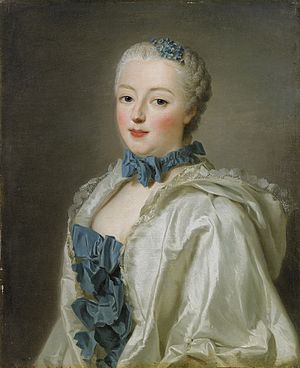
|
Françoise-Marguerite de Sévigné, comtesse de Grignan (1646–1705), was a French aristocrat. She is remembered for the letters that her mother, Madame de Sévigné, wrote to her over the course of thirty years. Françoise-Marguerite was a renowned beauty with a sharp wit, but was considered unbearably vain by Roger de Rabutin, comte de Bussy, another of her mother's correspondents. This oil-on-canvas portrait of the comtesse de Grignan was painted by Alexander Roslin in 1753, and is anachronistic in depicting her in mid-18th-century clothing. Painting credit: Alexander Roslin
Recently featured:
|
June 24

|
Manila is the capital of the Philippines and a highly urbanized city on the island of Luzon. It is the most densely populated city proper in the world as of 2018. The historic Spanish walled city was founded on June 24, 1571, by the Spanish conquistador Miguel López de Legazpi. This date is regarded as Manila's official founding date, although a settlement dating back as far as 1258 had existed on the site. Alongside Mexico City and Madrid, Manila is considered to be one of the world's original set of global cities due to its commercial networks being the first to traverse the Pacific Ocean; these connected Asia with the Spanish Americas, marking the first time in world history when an uninterrupted chain of trade routes circled the Earth. This map of the city proper of Manila indicates major roads, railways, parks and points of interest, as well as portions of surrounding municipalities. Map credit: Eugene Alvin Villar
Recently featured:
|
June 25

|
|
Westerhout 40 (W40) is a star-forming region in the Milky Way located in the constellation Serpens, approximately 1,420 light-years from the Solar System. This photograph, taken by NASA's Spitzer Space Telescope, reveals the stellar nursery in infrared light. A young cluster of several hundred stars is located at the center of the nebula, and stellar winds and radiation emanating from these stars have blown bubbles in the surrounding gas; the expanding bubbles have produced the rough shape of a butterfly seen in the image. Spitzer's Infrared Array Camera took this mid-infrared image in the 8.0-micron, 5.8-micron, 4.5-micron and 3.6-micron bands, here represented by red, orange, green and blue, respectively. Photograph credit: NASA/JPL-Caltech
Recently featured:
|
June 26

|
The ring-tailed lemur (Lemur catta) is a large strepsirrhine primate endemic to Madagascar, and the most-recognized lemur due to its long black-and-white ringed tail. The species is social, living in groups of up to thirty individuals, with females being dominant. It is considered to be an endangered species, with only about 2,000 ring-tailed lemurs left in the wild as of 2017; its main threat is habitat destruction, but droughts and harvesting for bushmeat or pets also take their toll. It breeds readily in captivity, and a similar number of animals are kept in zoos around the world. This ring-tailed lemur was photographed near Andasibe-Mantadia National Park in eastern Madagascar. Photograph credit: Charles James Sharp
Recently featured:
|
June 27

|
Helen Keller (June 27, 1880 – June 1, 1968) was an American author, political activist, and lecturer. She lost her sight and hearing after a bout of illness at the age of nineteen months. When she was seven years old, she met her first teacher and life-long companion, Anne Sullivan, who taught her language skills, including reading and writing. After attending Radcliffe College at Harvard University, she became the first deafblind person to earn a Bachelor of Arts degree. She worked for the American Foundation for the Blind for many years, during which time she toured the United States and traveled to 35 countries around the world. This 1920 photograph depicts Keller examining a magnolia flower. Photograph credit: Los Angeles Times; restored by Rhododendrites
Recently featured:
|
June 28

|
Lyman J. Gage (June 28, 1836 – January 26, 1927) was an American financier and Presidential Cabinet officer. From March 1897 until January 1902, he served as Secretary of the Treasury in the successive administrations of Presidents William McKinley and Theodore Roosevelt. Engraving credit: Bureau of Engraving and Printing; restored by Andrew Shiva
Recently featured:
|
June 29

|
The Church of St. Peter and St. Paul is a Roman Catholic church located in the Antakalnis neighbourhood of Vilnius, Lithuania. Constructed between 1668 and 1701, it is the centerpiece of a former monastery complex of the Canons Regular of the Lateran. The church is considered a masterpiece of Baroque architecture in the Polish–Lithuanian Commonwealth. This picture shows the central nave of the church, looking south-westwards towards the entrance. The nave is dominated by plain white walls that contrast with opulent decorations elsewhere in the church. It is decorated with colorful depictions of the Stations of the Cross and evenly spaced sculptures of the Twelve Apostles, as well as a number of torture scenes placed within niches featuring martyrs from the persecution of Christians in the Roman Empire. The pulpit, designed in the Rococo style, can be seen on the right of the photograph, while the pipe organ is visible above the entrance in the background. Photograph credit: David Iliff
Recently featured:
|
June 30
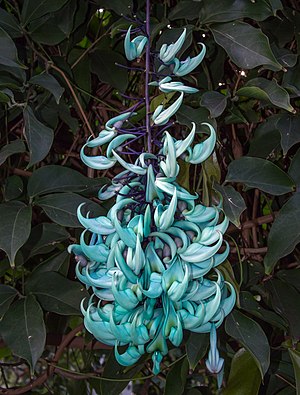
|
Strongylodon macrobotrys, the jade vine, is a species of leguminous perennial liana endemic to the Philippines. The woody stems can reach a length of up to 18 m (60 ft). A member of the family Fabaceae (the pea and bean family), the species has pendulous bunches of flowers which are followed by fleshy seed pods, and is pollinated by bats. This S. macrobotrys vine in bloom was photographed at the New York Botanical Garden. Photograph credit: Rhododendrites
Recently featured:
|
Picture of the day archives and future dates
